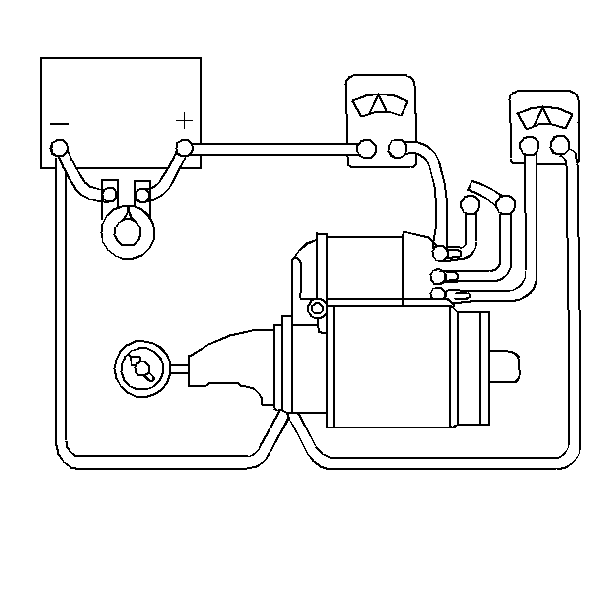Before disassembling the starter motor for repair, do the
following test:
- Secure the starting motor in a vise or suitable test stand.
- Turn OFF carbon pile and open the switch.
Caution: Keep fingers, tools, and any other objects away from the opening in
the drive end housing while making electrical connections. The strong shifting
action of the starter solenoid can cause severe personal injury
or damage to components as the drive pinion moves into the cranking position.

- Connect a voltmeter J 39200
from the starter
motor terminal to the starter motor frame (Ground), as shown.
- Connect the starter motor and an ammeter in series, from the positive
terminal of a fully charged 12 V battery.
- Connect a switch from the S terminal of the starter solenoid to
the starter motor terminal.
Notice: Never operate the starter motor for more than 30 seconds at a time.
Allow it to cool for at least two minutes. Overheating, caused by too much
cranking, will damage the starter motor.
- Close the switch.
- Adjust carbon pile load to obtain 10 volts on the voltmeter.
- Note the following meter readings:
| • | The armature speed on an RPM indicator |
| • | The current draw on an ammeter |
- Turn OFF carbon pile and open the switch.
- Compare the measurements with the specifications. Refer to Starter
Usage Table.
The test results indicate the following conditions:
| • | Rated current draw (amps) and rated no-load speed (RPM) indicate
the normal condition of the starter motor. |
| • | Low, no load speed (RPM) and/or high current draw (amps) could
indicate too much friction, causing the armature to drag. This can result
from any of the following conditions: |
| - | Tight, dirty, or worn bushings or bearings |
| - | A grounded or shorted armature |
| - | These conditions can be checked further on a growler, after disassembly. |
| • | Failure to operate (no RPM), with high current draw (amps), indicates
the following possible conditions: |
| - | A direct short to ground in the starter terminal or in the fields. |
| - | Seized bearings (This should have been noted by turning the armature
by hand). |
| • | Failure to operate (no RPM), with low or no current draw (amps),
indicates the following conditions: |
| - | An open or ground in the solenoid windings. |
| - | An open field circuit. This can be checked after disassembly by
inspecting the internal connections and by tracing the circuit with a J 34142-B
. |
| - | An open circuit in the armature coils. |
| - | Inspect the commutator for badly burned bars, after disassembly. |
| - | High insulation between the commutator bars. |
| • | Low, no load speed (RPM) and low current draw (amps), indicates
a high internal resistance caused by the following conditions: |
| - | Poor electrical connections |
| - | Defective electrical leads |
| - | Broken or weak brush springs |
| - | Other causes listed under test result number 4 (above). |
| • | High, no load speed (RPM) and high current draw (amps) indicating
shorted field coils or shorted armature windings. |
For further diagnosis and repair refer to:
| • | Starter Motor Disassemble |
| • | Starter Motor Inspection |

